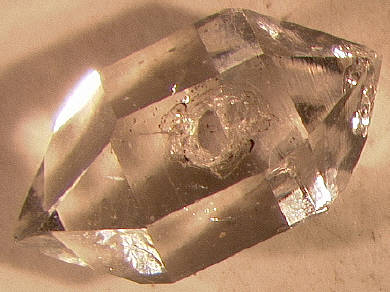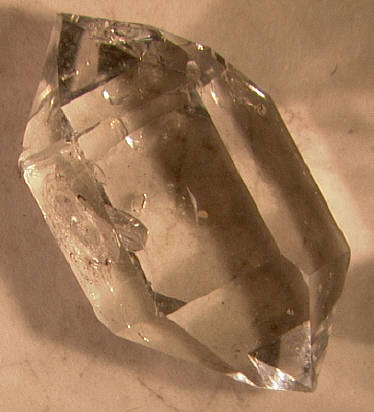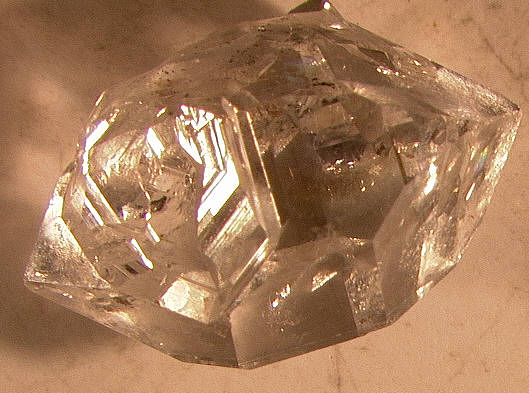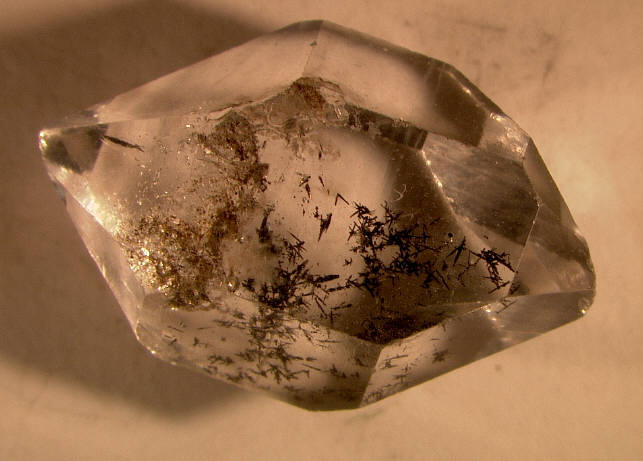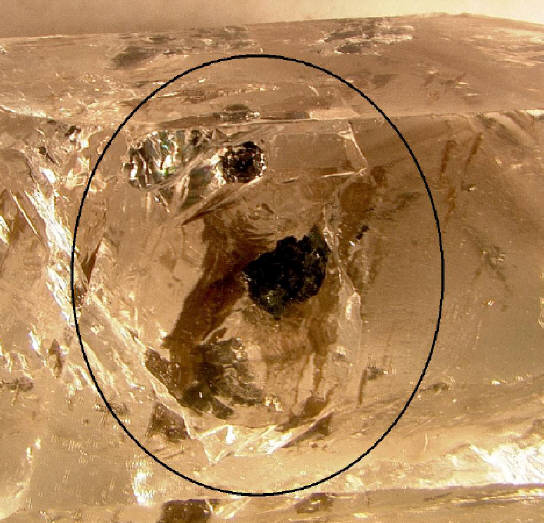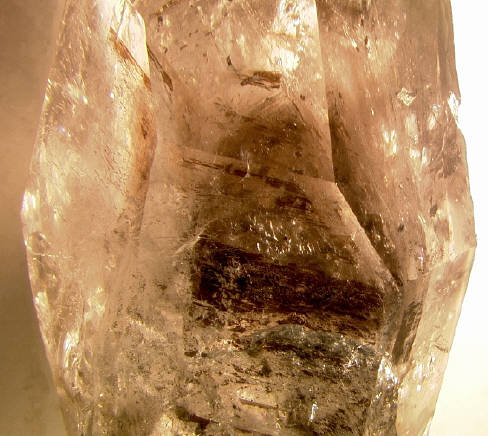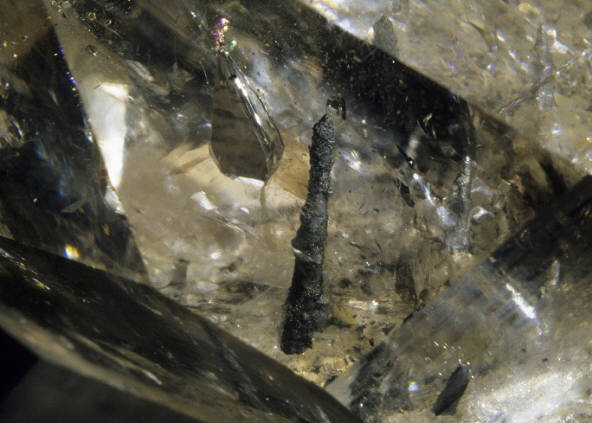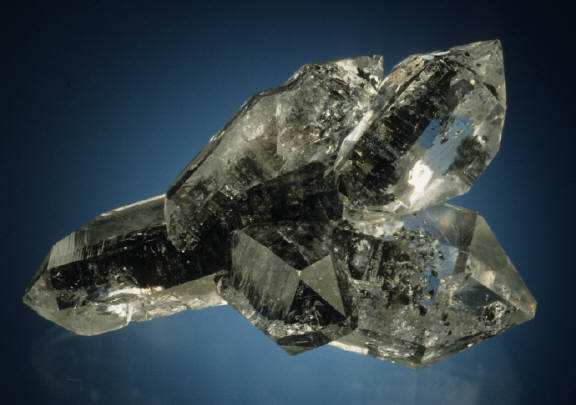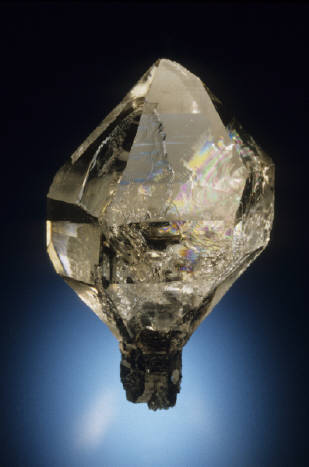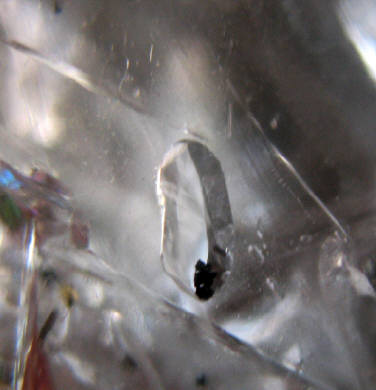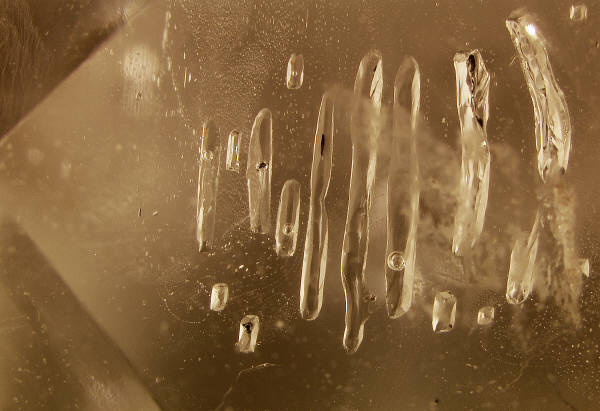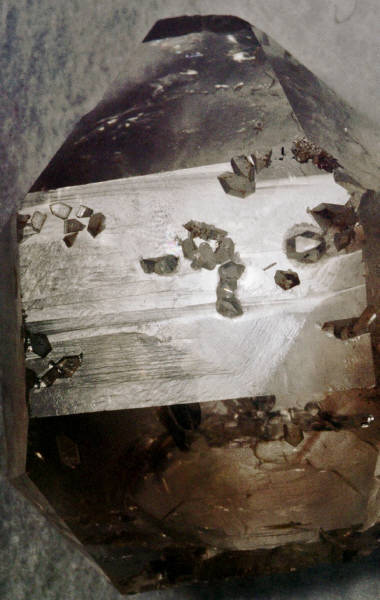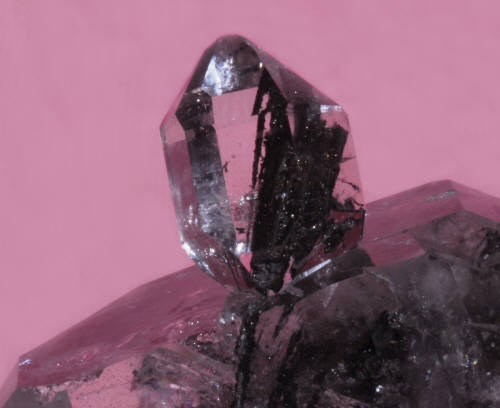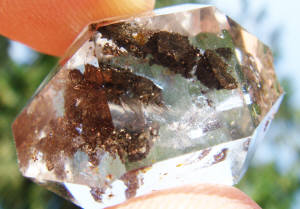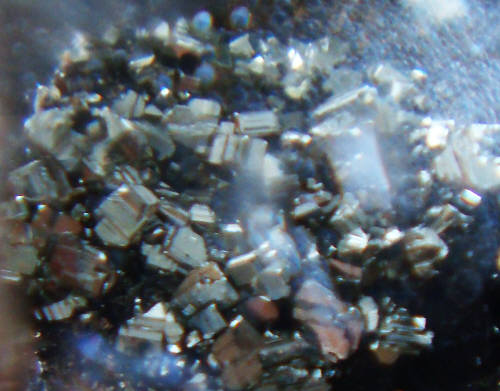This site was last updated on Sept, 2010
Quartz Crystal Habits within Herkimer Diamond Deposits
The best website on "Herkimer Diamonds"
Here are larger photos of the thumbnails presented on the main "Crystal Form" page. Included is identification information and the source link is embedded there (just click). In some cases additional information and comments are provided for each photo.
Please help with picture and sample donations!
Various inclusions, including scepters
On the left, this small Herkimer Diamond has within it what has been termed by collectors as a "manifestation", but which I advocate to be renamed as a "baby floater". The new name being more consistent with its origin.
To the right is a citrine clear crystal, 7 cm long, that has many "baby floater" contacts showing a number of different features. One the most interesting is a depression surrounding a protuding "baby". From Fonda, NY (DA), a unique citrine pocket, Mike Hoisington, 1972 (see also the single crystal on the singles page, and a group on the group page) Photo by DrD. 2008.
The next photo below is a closer shot focused under the flat face of this crystal, looking inside the crystal.
There is a group of "inclusions" along the edge that will help you to locate the above picture to a place on the upper crystal photo. Shown in the photo above there are quite a few "baby floaters" frozen within this crystal. They are all inside the crystal and you may see a "curtain" of striations that represents the crystal surface. Some of these inclusions are well formed and others are not and either have faded "ghost edges", or odd shapes, or both. There are also some second phase sulfide marcasite needles. This large amount of "baby foaters" in one specimen, with some poking out of the surface, is an important piece of field evidence regarding the formation of Herkimer Diamonds.
A public service project always open to input from the community interested in Herkimer diamonds.
There are a wide variety of shapes that occurs as scepters, phantoms and inclusions. We hope to have a photographic selection of them here that represents what occurs in the Herkimer district.
Crystals are approximately 3 cm point-to-point. The author of the photo states that the golden orange material is a fluid inclusion. It is posible that this is a "Golden Enhydro" and that the fluid is a form of "oil". It is interesting to see the "black hydrocarbon material" in the same crystals (but it may be outside as contact material on the back side of the crystal).
This photo on the right shows a crystal that has a piece of "baby floater" druze as an inclusion, along with second phase sufide needles. This "baby floater" druze can be seen on the baby floater druze picture for the same locale. It is basically hundreds of very tiny, poorly formed, Herkimer diamonds (and fragments) that are all stuck together. There are also some dolomite inclusions (light brown) on the right corner. Fonda, NY (DA) - 1992. Photo, DrD. Photo is 11 mm across.
Below: These are two photos of the same crystal. On the left there appears to be a "hole" with "shatter rings" around it. On the right photo you may be able to see that the surface of the crystal is perfectly smooth. The "hole" and the "rings" are all inside the crystal. Fonda, NY - 1982. Photo DrD.
On the left: This might not be called an "inclusion" as it is the contact point between two crystals. A normal contact between two crystals has flat edges, like the crystal's outside form. But in many small clear crystals it is not uncommon (at least at this location) to find hopper-like step contacts. Contacts like this say something about how Herkimer Diamonds were formed, and it is likely that such contacts are present in many of the pockets contating small clear Herkimer diamonds. From Fonda, NY (DA) - 1992. Photo, DrD., 2008
The photo on the left shows some nice inclusions of second phased sulfide needles (probably marcasite). The black color might be due to hydrocarbon material coating (personal communication, 2008, Marian Lupulescu, NY State Mineralogist). Specimen collected, Fonda, NY (DA) - 1992. Photo DrD.
Web page author - W. David Hoisington, Ph.D.
Click here and you will find some information about "enhydros" and a mention of oil as a fluid within Herkimer Diamonds.
A close-up photo of these small needle crystals is available on the sulfide page.
Most fluid inclusions, called enhydros by collectors, are transparent and not golden like in the above photo. Sometimes the fluid has a gas bubble in it that is also transparent and sometimes there are particles of other materials that move around inside the fluid inclusion, which makes them alot easier to see. Because the fluids, or gas (or both), are transparent inside a clear Herkimer diamond they are quite difficult to photograph.
On the left is a fluid inclusion, inside the circle. It has an irregular outline, as most do. The arrows should help you to see the outline. The small black fleck near the top, close to the crystal edge, is at the top of the fluid inclusion and it moves when you tilt the crystal. The larger black fleck in the middle also moves. Fluid inclusions come in a wide variety of shapes, but hopefully this picture will help you to know what to look for. Photo DrD, 2008.
This is a "phantom" crystal, which is basically a ghost, or phantom, form of the outer crystal that is within the crystal's interior. The reason we can see this phantom is that it is wrapped in thin layers of brown hydrocarbon material, most likely oil based. It is possible to see the layering at the arrow. This layering is a mirror image of the external crystal faces.
On the right is quite an unusual inclusion. Here is a "bumpy black rod" (most likely marcasite with alteration) part way inside the crystal and part outside. There also appear to be many fragments to the right of the rod and possibly an "enhydro" to the upper left. This is a Jeff Scovil photo of a specimen from the Bob Borofsky collection. It is from Little Falls, NY (TM), approximately 2.5 cm across the photo. Looking over the photos of Herkimers from this location, many have inclusions. More study on them could prove to be of value. Photo taken in 1999 and donated in 2009.
The photo the left shows the phantoms inside the prismatic crystal form that have turned to a dark black color (as compared to the brown shown above). The arrows point to the edges of the phantoms. The specimen is from Little Falls, NY (TM), JoLynn Assoc., 5.1 cm wide. Photo by Jeff Scovil, 1999 - donated 2009.
To the right is a scepter, a Herkimer diamond growing on top of a black (due to hydrocarbon)prismatic quartz crystal that also has strong parallel growth structure on its surface (you can see more of these on the Jeff Scovil page). This specimen is 3.4 cm high, from Little Falls, NY (TM) the Bob Borofsky collection. Photo by Jeff Scovil, 1999 - donated 2009.
Phantoms can become totally black and fill much of the crystal (see the photo below). They are most commonly associated with the large prismatic quartz. Such quartz is questionably called "Herkimer diamond", particularly when the common doubly terminated form of Herkimer diamond can be found growing on top of this black prismatic form (see second photo below). The darker color is due to hydrocarbon.
To the right is a fluid inclusion (locally called "enhydro"). It is about 5mm long and has a floating piece of black hydrocarbon. This is a nice, well defined, "bubble" quickly frozen inside the crystal while it was being formed. The specimen is from Middleville, NY - HDM. Photo was donated by Randall, April 2009.
To the right is a photo of "bubble trails" on the interior of a small Herkimer diamond. Distance across the photo is about 7 mm. Specimen is from Bob of N. Adams and was collected at DA in Fonda, NY 2008. By permission, photo DrD, 2009.
Of note are the small gas bubbles within the fluid inclusions, some with 2 rings indicating multiple phases, or types, of fluid/gas within the inclusion.
Below is a photo of marcasite rods inside a larger Herkimer diamond and moving up into a smaller crystal. Dr. D. photo 2010, permission from Frank. Collected at HBQ.
Below is a photo of small Herkimer with a series of black inclusions. What is interesting is that when light is passed through the bottom edges appear amber in color instead of black. Dr. D. photo 2010, permission from Frank. Collected in Middleville, NY - "The Ledges". This is similar to the color of the amber hydrocarbon sphere found - see the hydrocarbon page.
The term "manifestation" came from the idea that these crystal shaped inclusions represent empty space, or the "manifestation" of a crystal. New evidence, which is presented on this website, indicates that the baby floater phase is found through out the Herkimer district. That they were actually very tiny crystals and were in great abundance. Maybe a few turned into "manifestations", but the majority are probably small, "baby", Herkimer diamonds.
Scroll down to see another photo of amber brown inclusions.
How are these circular fracture features made while still having a totally smooth face on the surface?
An interesting inclusion of pyrite from HBQ, photos sent in by Adam, Aug., 2010. The top picture shows the crystal and the many inclusions. The arrow points to where the close-up was taken. The close up is on the right.
|




